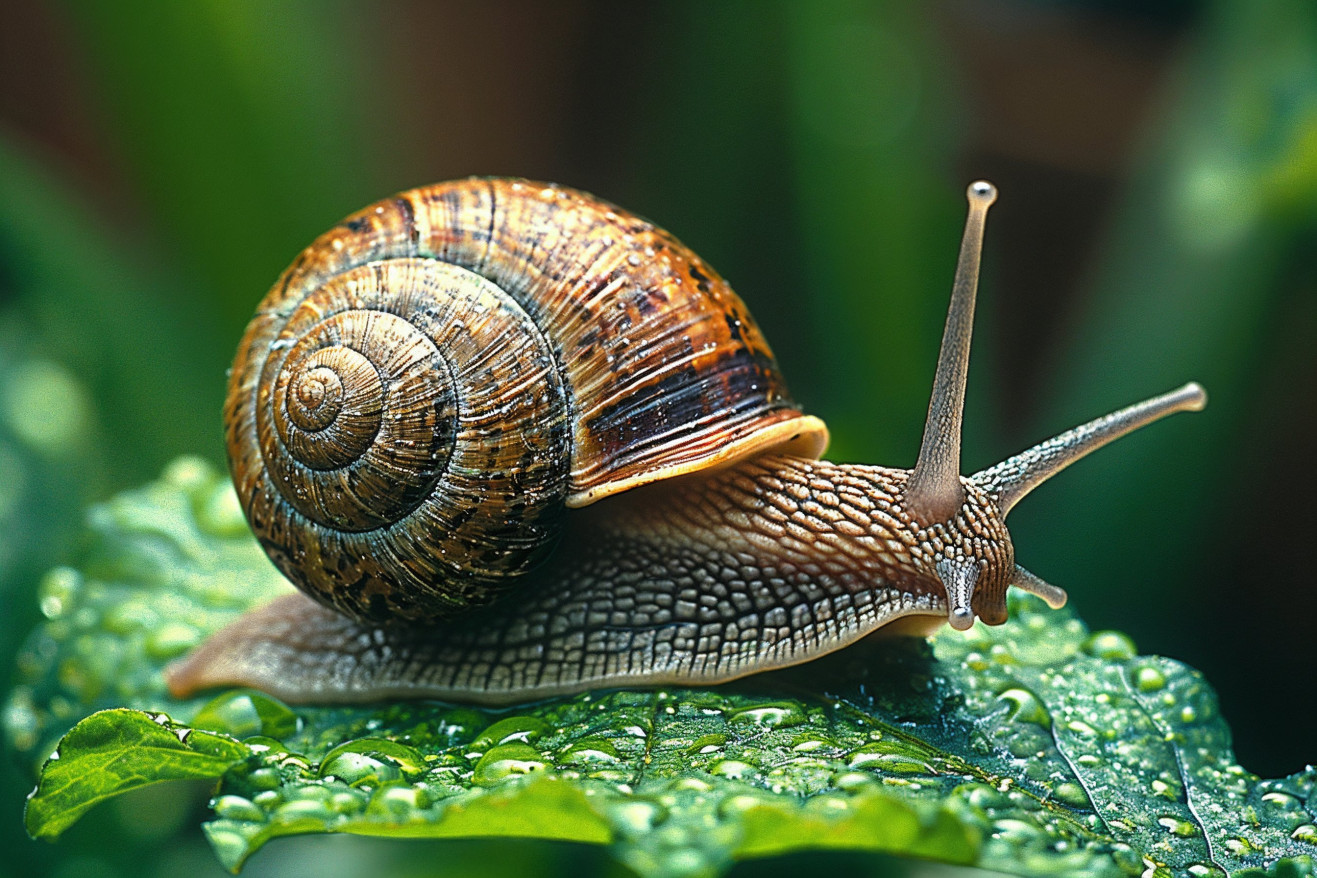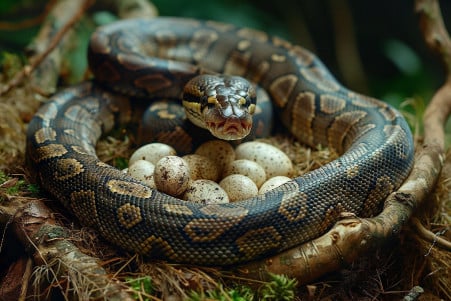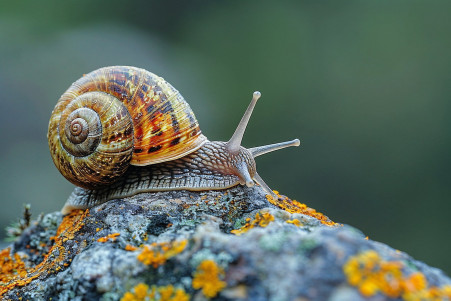Snail Reproduction: An In-Depth Look at Egg-Laying
29 March 2024 • Updated 27 March 2024

Are snails egg layers, and if so, what does the egg-laying process look like? Most snail species are oviparous, which means they lay fertilized eggs in clumps or strings that eventually hatch into larvae. These eggs are laid in places like under logs, rocks, or leaves and are covered in a protective layer of mucus that helps keep them moist and safe until they hatch.
In this article, we'll take a look at research from malacology and reproductive biology to uncover the fascinating life cycle of these unassuming mollusks. From their egg-laying habits to the structure of their eggs to the length of time it takes for them to hatch to the ways in which the larvae emerge, you'll walk away with a deeper understanding of the intricate reproductive processes that have allowed these animals to survive and thrive on Earth.
Do snails lay eggs?
Land vs. Aquatic Snail Egg-Laying Behaviors
Land and aquatic snails have evolved different egg-laying behaviors to suit their specific environments. Land snails lay their eggs in damp, protected areas such as under logs, rocks, or leaf litter, according to Miche Pest Control. Meanwhile, aquatic snails lay their eggs in gelatinous capsules that are attached to submerged surfaces or aquatic plants, according to AquaInfo's guide.
The eggs of the two types of snails also have different physical characteristics. Land snail eggs are generally a bit larger, with diameters that range from 2-10mm, while the eggs of aquatic snails are smaller, with diameters that range from 1-6mm, according to Miche Pest Control's descriptions. In terms of color, land snail eggs can be opaque white, brown, or dark, while aquatic snail eggs are translucent, pale, or covered in algae. And in terms of texture, the eggs of aquatic snails are encased in a protective gelatinous mass, as indicated in AquaInfo.
These differences are the result of the snails' evolutionary adaptations to their environments. The gelatinous capsules of aquatic snails' eggs provide protection and moisture, while the eggs of land snails are protected by their camouflage and the locations in which they are laid, according to the review in this MedCrave article. Understanding these differences can help us appreciate the amazing diversity of snail reproduction.
Incubation and Hatching: From Egg to Larva
Freshwater snail eggs typically take 2-4 weeks to hatch, according to Pets on Mom.com. That said, the incubation period can vary greatly from species to species. For example, mystery snail eggs can take anywhere from 10 days to 4 weeks to hatch, according to this guide from Florida Mystery Snails.
In addition to the length of the incubation period, the eggs also go through a number of changes that are visible to the naked eye. After being laid, the eggs are soft and milky, but they harden and change color soon after, according to Pets on Mom.com. The speed at which these changes happen and the time it takes for the eggs to hatch can be impacted by the temperature and humidity of the environment, which is why the incubation periods of the mystery snail eggs that were laid so close together in time were so different.
Once the eggs are ready to hatch, the larvae, or young snails, come out of the eggs. Study.com's overview notes that during the larval stage, snails experience torsion, a process that causes the body mass to shift to one side, which brings the head and anus closer together. After hatching, the larvae go through further development to become adult snails.
Ensuring the Survival of the Next Generation: Egg Defense Mechanisms
In addition to environmental factors, snail eggs are also susceptible to a range of other dangers during the sensitive incubation period, including predation. According to Friends of Island Beach State Park, the eggs of moon snails are often consumed by carnivorous planarian flatworms that can detect the jelly-like egg masses and then burrow into them to eat the embryos. The egg masses also attract seed shrimp that consume any leftover embryos.
To help ensure the survival of their eggs, some snail species have evolved to create protective nests or casings around their egg clutches. Snail World explains that when land snails lay their eggs, they do so in holes they dig in the ground and then cover them with a protective layer of mucus. Meanwhile, the apple snail Pomacea canaliculata goes a step further by depositing its bright pink-reddish egg clutches outside of the water and then cementing them in place to warn off visual predators, according to a study published in PMC.
In addition to physical defenses, some snail species have evolved to use chemical defenses to protect their eggs. The PMC study found that apple snail eggs are toxic due to the presence of neurotoxins and proteins that reduce their digestibility, which in turn makes them less appealing to predators. These adaptations demonstrate the importance of protecting the next generation in the evolution of snails and the survival of their species.
Environmental Factors That Impact Egg Development
The success of snail eggs and the subsequent hatching of those eggs is impacted by a number of environmental factors, many of which were outlined in recent studies. One such study, published in TropicalMed, found that the distribution and abundance of freshwater snail species in China was impacted by a number of physical, chemical, and biological factors.
Water quality parameters like pH, dissolved oxygen, and chlorophyll-a levels were positively associated with snail fecundity, hatchability, and survival, according to research published in PubMed. Meanwhile, higher water temperatures and dissolved carbon dioxide were negatively associated with these reproductive factors. The study also found that snails in polluted waters had longer hatching periods.
In addition to water quality, the physical structure of the habitat and biological factors like the presence of predators also matter. One study published in PMC found that snail abundance and trematode infection rates were higher in agricultural areas with lower canopy cover and more human disturbances than forested areas. This shows that changes in land use can create conditions that are more conducive to snail egg development and survival.
When you take these findings together, it’s clear that a variety of environmental factors, from the chemistry of the water to the characteristics of the habitat, can impact the success of snail egg-laying and hatching. Understanding these factors is important for managing snail populations and the diseases they help spread.
Parental Care: Snail Egg-Tending Behaviors
The studies cited in this article do not mention any parental care behaviors that snails exhibit toward their eggs after they have been laid. Some research, however, has suggested that certain snail species may engage in some egg-tending behaviors.
As noted by Snail World, land snails sometimes create protective nests or cases around their egg clutches, which could be seen as a form of care and protection. The TropicalMed study also observed that abundant aquatic vegetation can provide a safe haven and breeding ground for snails, which could indirectly help with the development of their eggs.
In addition to these protective measures, there is little evidence that snails tend to their egg clutches by maintaining or regulating their environment. The PubMed study found that environmental factors such as water quality and temperature had a more significant effect on the hatching success of snail eggs than parental care.
While parental care behaviors could potentially lead to better egg survival and hatching success, the inherent limitations of snail physiology and reproductive strategies may make it difficult for them to provide extensive care after their eggs are laid. The demands of protecting and monitoring widely dispersed egg masses in a variety of environments may make it difficult for most snail species to provide parental care.
Conclusion: The Remarkable Resilience of Snail Eggs
The ability of snails to reproduce by laying fertilized eggs is a testament to the resilience and adaptability of these creatures. From the different ways that land and aquatic snails lay their eggs to the amazing defense mechanisms that protect them, snails have evolved a variety of methods to ensure the survival of their offspring.
An understanding of the complexities of snail reproduction, from incubation to hatching, and the importance of environmental factors is essential to the conservation of these important members of ecosystems around the world. Despite the many obstacles they face, snails continue to thrive, and their resilience is a source of amazement and inspiration to all who study these complex invertebrates.


